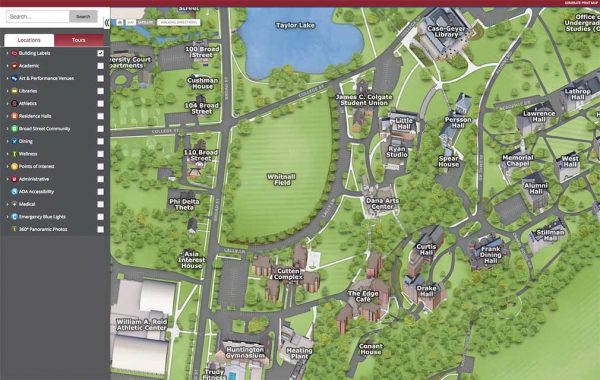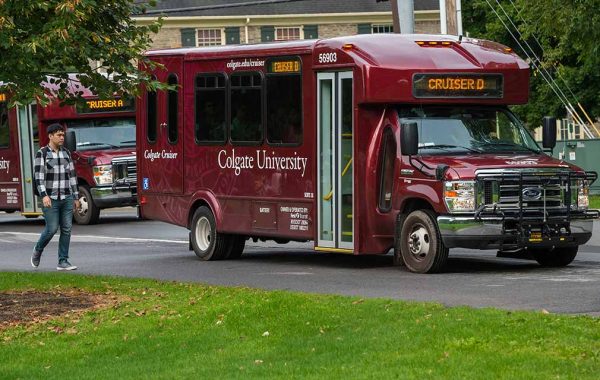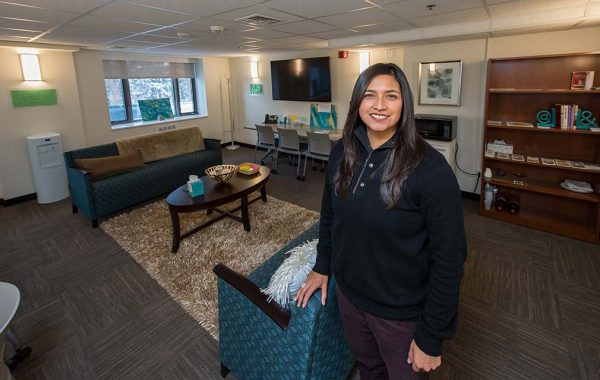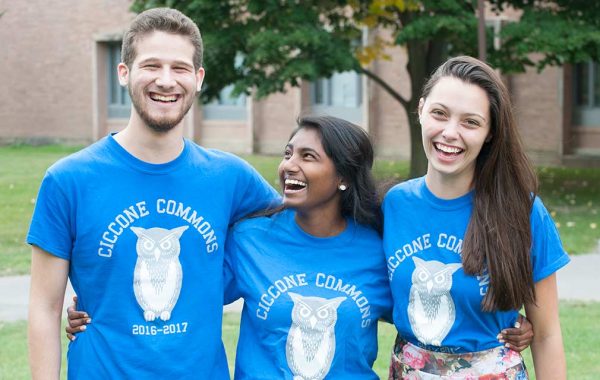Above: Taking the long view of Chapel House history with Vassar’s Nicholas Adams. (Photo by Nick Gilbert ’18)
Chapel House reopens after renovations
Both an architectural novelty, with its flat roof and 1950s abstracted formalism, and a sanctuary, Chapel House is where you’ll find rare works of religious art and books on world religion, as well as a dining room, music room, and living quarters. In silence and meditation, you can lose yourself or find yourself at Chapel House, depending on your objective.
An anonymous gift, made by a woman nearly 60 years ago, created this unique retreat as a place where people of faith — or people of no faith — could seek out religious insights and spiritual nourishment. Colgate reaffirmed this mission with renovations that make the facility more sustainable and accessible.
In keeping with the space itself, the reopening ceremony was far from ordinary. It featured a welcome from Chapel House Director Steven Kepnes and introductory remarks from President Brian W. Casey. Japanese Zen master Jeff Shore spoke passionately about Chapel House’s reach across oceans and generations.
Vassar College art professor Nicholas Adams guided students, professors, alumni, and friends on an intellectual tour through the house’s physical, philanthropic, and religious heritage. He also highlighted the deep-seated commitment to religious exploration that moved “the lady” (as the anonymous woman was known) to fund the project, as proposed by Ken Morgan, Colgate religion professor and first director of Chapel House.
“The lady offered Morgan $600,000 for his meditation center, with two requests: her name ‘was never to be mentioned, and she must approve the architectural plans,’” Adams said.
Charles Hallisey ’75, now the Yehan Numata Senior Lecturer on Buddhist literatures at Harvard Divinity School, reminisced about life as a student working in Chapel House. Hallisey’s undergraduate experience had been shaped by the building and the ethos of those who ran it, including legendary faculty members like Morgan and John Ross Carter, the second director of Chapel House. The lady reportedly believed that her project would be worth the money if even one person found meaning in Chapel House. “I am that one person,” Hallisey said.
“Our anonymous benefactor could have no idea that she was creating a rare oasis of peace in a continuously connected world,” Casey said. “Her original intent still resonates and serves as the primary focus of this beautifully designed, carefully restored home. But the impact of her generosity has expanded with the decline of silence and solitude in our society.”
Students write notes of thanks

In December, Drew Riley, associate dean of admission, found a notecard in his staff mailbox that simply read, “Happy holidays and thank you for all you do to make Colgate the incredible place it is!”
It was signed by someone named Dana. Riley thought the nice gesture might be from someone he met while recruiting, until he ran into another member of the admission staff who received a similar letter — and someone in accounting … and the registrar’s office … and ….
Hundreds of professors and staff members received the personal, handwritten notes, each signed by individual students or with a broader “Colgate students” signature.
Jenny Lundt ’19, a Benton Scholar and chair of the Student Government Association’s (SGA) External Relations Committee, said she and six fellow committee members thought of the idea to spread a little extra cheer around campus this year.
“There are so many people in this community who work to improve our lives here, and they receive very little recognition in return,” Lundt said. “We decided that we wanted every staff member to get a handwritten letter from a student thanking them.”
Members of the SGA, RetroText (a letter-writing group), and DoRAK (Do Random Acts of Kindness) hosted a night of card writing in Case Library.
“We got some funding and provided stationery,” said RetroText founder Ben Fetzner ’17. “It was extremely well attended. We had the names of all the faculty and staff, and people could comb through the list and look for people they wanted to write to.”
In total, Lundt said, nearly 100 students came together just days before finals to write approximately 600 letters.
“Going to deliver them was one of the most fun things I’ve done in my time here,” Lundt said. “It took only a few minutes out of students’ days for a lot of happiness to spread throughout campus.”
Congressional debate brings national issues to Colgate
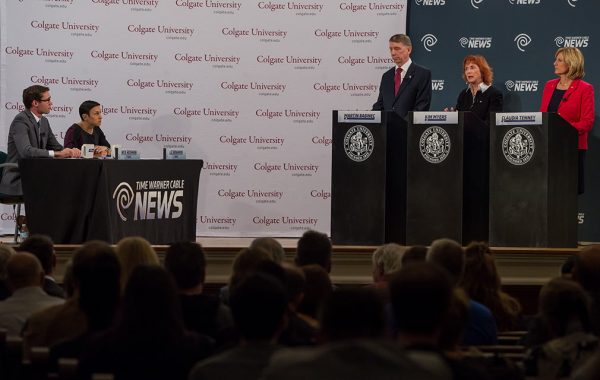
Claudia Tenney ’83 (far right) was elected to Congress in November after participating in this debate against her opponents in Memorial Chapel on Oct. 20, 2016. (Photo by Mark DiOrio)
National and state issues, ranging from gun control to refugee resettlement and the future of job creation in New York State, dominated a pre-election debate among the candidates for the 22nd Congressional District hosted by Time Warner Cable News in Memorial Chapel.
An opportunity for those interested in political science, debate, or any of the many politically oriented clubs on campus, the event provided students as well as members of the local community a front-row seat to democracy in action.
Independent Martin Babinec, Democrat Kim Myers, and Republican Claudia Tenney ’83 campaigned for one of the most contested congressional seats in the nation, with more than an estimated $8 million spent by the campaigns and outside political groups. Ultimately, Tenney won with 46.5 percent of the vote in the November election, becoming the first alumna to represent Colgate’s district in Congress.
Watch the debate here.
The campus in 360 degrees
Colgate partnered with CampusBird — the same company that charts Disney’s theme parks — to create a new online campus map with video, photos, 360-degree panoramas, walking directions, and links to the university website.
The new map features custom, digital models of each historic building on campus and many off-campus Colgate properties. It not only showcases the beauty of Colgate, but also is a powerful tool to assist prospective students and parents, as well as members of the community.
The mobile-friendly design has icons that can be toggled on and off to help users quickly find what they are looking for. Custom tours can be added for special events, and a walking tour is now available for visitors arriving on campus during off hours.
With instant updates, the map allows custom content to be added for special events and exciting campus additions, such as the new Class of 1965 Arena.
Rolling out new Colgate Cruisers
The university’s free shuttle service has a new maroon fleet of handicap-accessible vehicles that have route signs above the windshield and feature bike racks. The cruisers still stop at the same designated pickup locations on campus, as well as off campus, including the Colgate Bookstore, Parry’s Hardware, and Price Chopper.
Honor roll of access
ScholarMatch, a San Francisco nonprofit organization that provides free college counseling to low-income youth, has named Colgate to its 2016 College Honor Roll. The honor roll recognizes approximately 300 institutions that offer supportive environments for students whose families earn less than $50,000 per year.
According to ScholarMatch, 21 percent of high school seniors don’t have access to a school counselor. The organization’s honor roll is meant to help prevent low-income and first-generation students from “undermatching” their choice of prospective colleges with those beneath their qualifications.
Working with the White House, ScholarMatch used public data to evaluate 1,400 schools in four main areas: financial aid, academic strength, student support services, and postgraduate success — with specific consideration given to low-income students’ needs. ScholarMatch’s analysis included metrics that are specifically relevant for students from households earning less than $50K, such as loan default rates and average debt load at graduation for this income bracket.
Colgate continues to make access and affordability a key priority, including meeting 100 percent of demonstrated need for all accepted students. The university has doubled spending on financial aid in the past 10 years, and the average debt load of Colgate graduates is considerably lower than the national average of more than $27,000; for example, the average debt load for the Class of 2016 was $16,000.
A new Haven
With the opening of Haven, Colgate’s new sexual assault response center, in October, the Scene sat down with Denise Contreras, the assistant director of survivor support services. Located in Curtis Hall, Haven provides confidential care, support, advocacy, and clinical services for survivors of sexual assault and other forms of violence. In addition, the staff offers sexual assault awareness and prevention programming in collaboration with on- and off-campus partners.
Tell us about the center’s work.
Haven’s outreach efforts involve fostering dialogue about gender-based violence, relationship violence, power and control, consent, characteristics and associated problems of nonconsensual sex, bystander education, and surviving sexual violence.
Haven has partnered with several departments on campus for prevention efforts and education and to build awareness of our available counseling services. The counseling center hired Natasha Torres ’15 to serve as the residential fellow for sexual assault response initiatives. At the start of the semester, we partnered with the Office of Equity and Diversity. We also made contact with the athletics department and talked with athletes about sexual violence and support services. In addition, we presented to all of the student group leaders — approximately 400 students — to educate and discuss prevention awareness concerning sexual violence. Other efforts include classroom workshops, speak outs, clothesline projects, and supporting This Is Not A Play About Sex and Yes Means Yes.
Explain the role of Colgate’s sexual violence coalition.
We have collaborated with campus partners including campus safety, athletics, Greek life, the Shaw Wellness Institute, women’s studies, and other departments as well as students to strategize once a month on campus needs. In our first meeting, we established a group of students, staff, and faculty who are committed to supporting students who experience sexual violence, bias, or harassment. We will partner with the efforts already taking place at Colgate.
Tell us about your community outreach efforts.
We’ve connected with Liberty Resources’ Victims of Violence in Oneida and the State Police Campus Sexual Assault Victims Unit to collaborate on services, receive training, and expand confidential services to our students.
Recently, we went to the Rotary Club in Morris to let them know about the services and how we talk about rape culture to this generation of students. They’re eager for this information. The president of the Rotary came to This Is Not a Play About Sex and said, “I want all of our Rotary to be part of this next time so that they can begin that dialogue with their own families and community” — which is great; it’s passing along that positivity.
What brought you to Colgate?
I’m originally from San Antonio, Texas, and earned my master’s degree in social work from Texas State University after serving in the U.S. Air Force for seven years. In August 2014, my partner, Cristina Serna, was hired for a tenure-track position at Colgate as an assistant professor in women’s studies.
I spent my first year learning about upstate New York and the Colgate campus culture. I volunteered with the Hamilton Area Community Coalition, and was employed part time at the equity and diversity office at Colgate as well as the Madison County Rural Health Council in Oneida. I was hired for the 2015–2016 academic year to serve as a staff counselor at Colgate’s counseling center.
With Haven, I have an opportunity to directly support students while addressing sexual violence on campus. It is an honor to advocate for and support the students. I feel blessed to work with such a dynamic and supportive team as we extend Haven’s survivor support services.
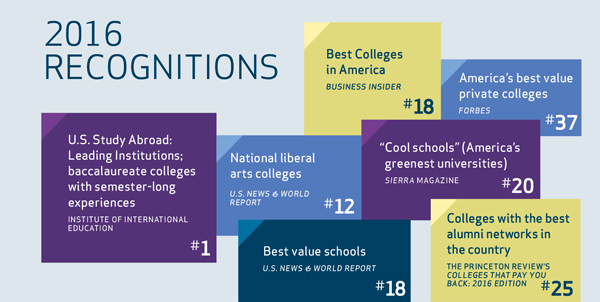
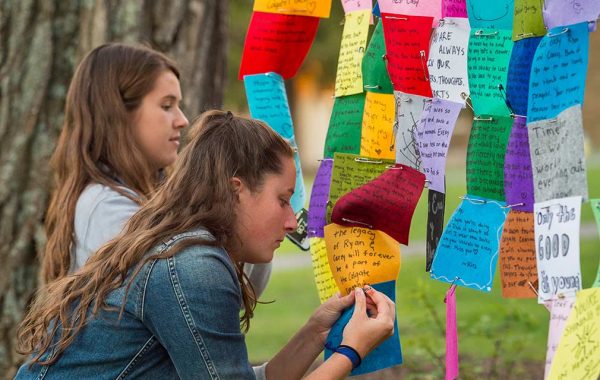 The campus community gathered in the chapel on Sept. 20, 2016, to honor the lives of Ryan Adams ’19 and Cathryn (Carey) Depuy ’19, who died on that date in a 2015 plane crash in Morrisville, N.Y. Konosioni invited people to the Quad before the vigil to write memories, wishes, or thoughts on colorful felt squares. (Photos by Mark DiOrio)
The campus community gathered in the chapel on Sept. 20, 2016, to honor the lives of Ryan Adams ’19 and Cathryn (Carey) Depuy ’19, who died on that date in a 2015 plane crash in Morrisville, N.Y. Konosioni invited people to the Quad before the vigil to write memories, wishes, or thoughts on colorful felt squares. (Photos by Mark DiOrio)
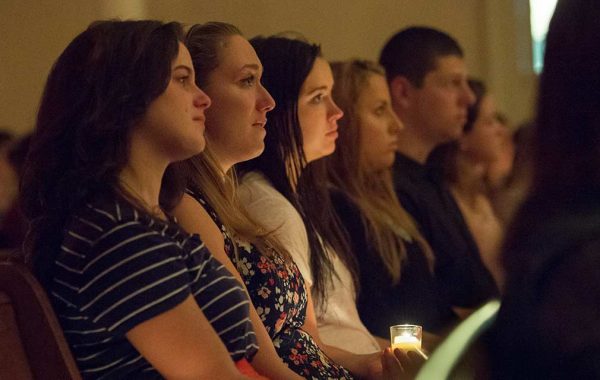
Shirt tales
The new Ciccone Commons spirit wear is a real hoot! The cerulean blue T-shirts, given to students in Curtis and Drake halls’ residential community, feature the fine feathers of the community’s mascot: the owl.
Commons Community Leader Alex Goldych ’19 explained that the choice of mascot came largely from student input. “We wanted the animals to be indigenous to New York State. So, after narrowing it down to four different animals — the owl, sea otter, bear, and fox — we held a debate where residents argued for their top choice.”
And while the owl was not chosen to represent the trope of avian wisdom, that value does align with those espoused by Diane Ciccone ’74, the community’s namesake. In a lecture given to commons residents last spring, Ciccone set forth the values that she wished to be infused into the community: service, knowledge, inclusivity, and learning.
Community Leaders Melissa Persaud ’17 and Alec Hufford ’18 said that this commitment to inclusivity is what drew them to the commons.
“I think that inclusivity is the next big thing that will happen to social life here at Colgate,” said Persaud, “and the commons is a great way to help students both navigate the social culture here and also build their own social circles.”
Hufford agreed, noting that he’s already observed this happening among his residents. “I’ve seen students planning their own events, putting hammocks up, hanging out, and singing together,” he said. “That is exactly what I wanted to see happen here.”
— Brianna Delaney ’19
Back on campus
“As a technique, it’s very easy to learn, and what you experience is a deep, profound level of rest… It’s rest that then becomes the basis for all the different benefits, like clear thinking, more energy, and better academic performance.”
— Randy Mackenzie ’71 gave an informational session on transcendental meditation and stress reduction meditation at the Shaw Wellness Institute in November.
Village Green
Luminaries lit the way on the evening of December 5 as the community gathered on the Village Green for the annual Night of Lights. The tree lighting — with approximately 2,800 twinklers — is the focus of the event, which started in 1937. Horse-drawn wagon rides, performances by Colgate a cappella groups, fire pits for making s’mores, cookies, hot chocolate, and a collection for the Toys For Tots charity make for “a heartwarming event. It’s small town at its best,” said Joanne Borfitz, Colgate’s associate vice president for community affairs. The event was presented by the Hamilton Rotary, in partnership with the Hamilton Business Alliance and the Village of Hamilton.
 From apple-Brie pastries to gourmet bagel sandwiches, Britty Buonocore ’12, MAT ’13 has rolled out a mouthwatering menu with the opening of Flour & Salt Bakery at 7 Maple Avenue. Specialty ingredients like duck eggs and locally made products, including Kriemheld butter and Ray Brothers’ barbecue sauce, make the bakery a standout. Buonocore also plans to use the storefront as a venue for monthly music performances, baking classes, and other community events.
From apple-Brie pastries to gourmet bagel sandwiches, Britty Buonocore ’12, MAT ’13 has rolled out a mouthwatering menu with the opening of Flour & Salt Bakery at 7 Maple Avenue. Specialty ingredients like duck eggs and locally made products, including Kriemheld butter and Ray Brothers’ barbecue sauce, make the bakery a standout. Buonocore also plans to use the storefront as a venue for monthly music performances, baking classes, and other community events.
Sign of the times: A new placard has been added to the village’s “Welcome” sign to honor John Vincent Atanasoff, the inventor of the computer, who was born in Hamilton and whose father attended Colgate. Atanasoff was born in 1903 to Ivan, Class of 1901, and Iva (Purdy). As a mathematics and physics professor at Iowa State College, Atanasoff received a grant in 1939 to build what would be called the Atanasoff Berry Computer (ABC).


